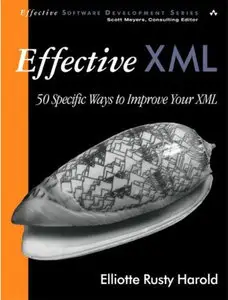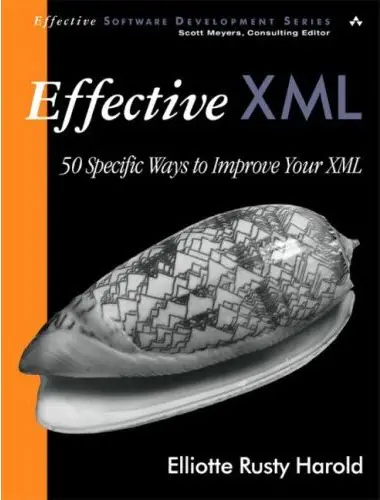Effective XML: 50 Specific Ways to Improve Your XML
ISBN-10: 0321150406 | English | CHM| 1 Mb | 336 Pages | Publisher: Addison-Wesley Professional; 1st edition (September 12, 2003)
This is an excellent collection of XML best practices: essential reading for any developer using XML. This book will help you avoid common pitfalls and ensure your XML applications remain practical and interoperable for as long as possible.
If you want to become a more effective XML developer, you need this book. You will learn which tools to use when in order to write legible, extensible, maintainable and robust XML code:
- How do you write DTDs that are independent of namespace prefixes?
- What do parsers reliably report and what don't they?
- Which schema language is the right one for your job?
- Which API should you choose for maximum speed and minimum size?
- What can you do to ensure fast, reliable access to DTDs and schemas without making your document less portable?
- Is XML too verbose for your application?
Table Of Content:
Item 01. Include an XML Declaration
Item 02. Mark Up with ASCII if Possible
Item 03. Stay with XML 1.0
Item 04. Use Standard Entity References
Item 05. Comment DTDs Liberally
Item 06. Name Elements with Camel Case
Item 07. Parameterize DTDs
Item 08. Modularize DTDs
Item 09. Distinguish Text from Markup
Item 10. White Space Matters
Item 11. Make Structure Explicit through Markup
Item 12. Store Metadata in Attributes
Item 13. Remember Mixed Content
Item 14. Allow All XML Syntax
Item 15. Build on Top of Structures, Not Syntax
Item 16. Prefer URLs to Unparsed Entities and Notations
Item 17. Use Processing Instructions for Process-Specific Content
Item 18. Include All Information in the Instance Document
Item 19. Encode Binary Data Using Quoted Printable and/or Base64
Item 20. Use Namespaces for Modularity and Extensibility
Item 21. Rely on Namespace URIs, Not Prefixes
Item 22. Don't Use Namespace Prefixes in Element Content and Attribute Values
Item 23. Reuse XHTML for Generic Narrative Content
Item 24. Choose the Right Schema Language for the Job
Item 25. Pretend There's No Such Thing as the PSVI
Item 26. Version Documents, Schemas, and Stylesheets
Item 27. Mark Up According to Meaning
Item 28. Use Only What You Need
Item 29. Always Use a Parser
Item 30. Layer Functionality
Item 31. Program to Standard APIs
Item 32. Choose SAX for Computer Efficiency
Item 33. Choose DOM for Standards Support
Item 34. Read the Complete DTD
Item 35. Navigate with XPath
Item 36. Serialize XML with XML
Item 37. Validate Inside Your Program with Schemas
Item 38. Write in Unicode
Item 39. Parameterize XSLT Stylesheets
Item 40. Avoid Vendor Lock-In
Item 41. Hang On to Your Relational Database
Item 42. Document Namespaces with RDDL
Item 43. Preprocess XSLT on the Server Side
Item 44. Serve XML+CSS to the Client
Item 45. Pick the Correct MIME Media Type
Item 46. Tidy Up Your HTML
Item 47. Catalog Common Resources
Item 48. Verify Documents with XML Digital Signatures
Item 49. Hide Confidential Data with XML Encryption
Item 50. Compress if Space Is a Problem
Download from Uploading
or
Download from Depositfiles
or
Download from FileFactory
No Mirrors below, please! Follow Rules!
More serious and useful books!:
Vol.1. 2000 ebooks, 27 Gb
Vol.2. 2000 ebooks, 8 Gb
Vol.3. 1800 ebooks, 21 Gb





